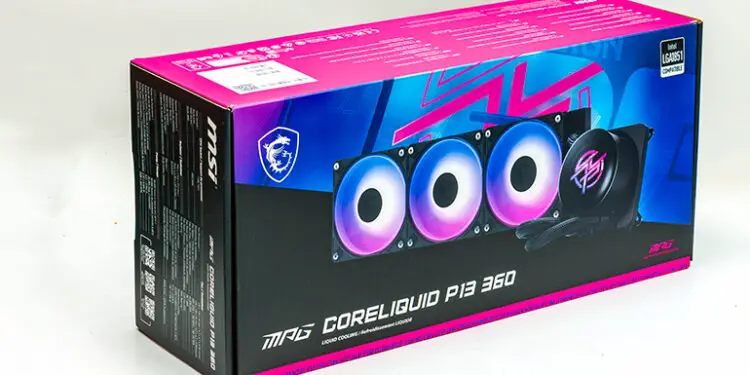
It is not a stretch to say that one of the CoreLiquid P13 360’s most defining and innovative features is MSI’s Uni-Bracket-based installation system. We say this as it was obviously designed with both seasoned system builders and first-time builders in mind… as it Just Works. Works so well that it gives the CoreLiquid P13 easily one of the best and yet easiest AIO installation procedures you can find. Yes. On paper, this seemingly simplistic tweak to the standard installation path should not be a game-changer. Yet in the real world, it is just that: a game-changer. One that is so innovative, so refreshingly simplified, it leaves the competition in the dust. To be blunt, it turns what is typically a moderately easy installation into the easiest one imaginable.

To put this in perspective: most experienced builders can identify an OEM’s handiwork (regardless of the label on the AIO) by the peculiar frustrations their brackets, backplates, and/or screws impose. Asetek’s reliance on delicate screw top plates, Alpatek’s (relatively) finicky brackets, Arctic’s hardcore tensioning ‘spring’, and Cooler Master’s sometimes temperamental threading are well-known to those initiated into the Brotherhood of Blud & Water. MSI’s design, on the other hand, sidesteps basically all of these issues.

This is because rather than battling against torque, threading, and precarious alignments, the P13 360’s UNI-Bracket system utilizes an all-in-one approach to both the top and bottom hardware brackets… as it is both legitimately all in one with both Intel and AMD support baked into both. Once again, on paper, that shouldn’t be a Good Thing™… and yet it is. We say this as typical, yet we are not fans of all-in-wonders because compromises pretty much have to be made in order to fit radically different sockets. But this is one of the few times with the benefits easily outweigh, and arguably nullify, the negatives.

For example, counter-acting the extra girth is the fact that you only have to install one bracket so if you swap from Team Red to Team Blue (or vice-versa) later on, you are not hunting for the proper bracket in your parts bin. In fact, there is only one set of (four) bolts and (four) nuts you have to worry about.

The four nuts work on all rigs, so once again you need not worry about hunting for the “right” ones later on when it comes time to upgrade your system. While it is true that the double-ended bolts may come in three types instead of being ‘All In One’, each set is different enough from each others so as to be easy to tell apart.

Which leads us to the pure premium feature that all AIOs must start baking into their design ASAP. No. Not that gorgeous IPS-based LCD. That is a nice, but while well executed is not a unique feature. Rather, it is the cherry on top of the ice cream Sunday. Not the Sunday itself. Instead, the price premium justifying innovation comes from the EZCap fascia. A simple piece of plastic may not sound like much, but when installed over the securing top “C” bracket… all those tradeoffs are neatly covered in an “out of sight, out of mind” fashion no other AIO can even come close to matching.

Furthermore, cleanliness and professionalism is taken to a whole new level via this innovative covering. A level that until you have experienced it first hand you can’t really accurately describe it. It is like trying to describe the color blue to the colorblind.
Moving on.

For some the pure copper contact plate and its pre-applied TIM will be a net positive. For others, it will be a net negative… and result in an extra step (aka cleaning it off) before one applies their own TIM of choice. We fall into the former category rather than the latter… as the only time we care about TIM these days is if a build is going to be left alone for more than 4 years. Then we typically either opt for diamond… or you know… go HoneyWell PCM (PTM7950) and pad it out. Beyond that a degree or two difference between say Shin Etsu vs DuPont vs Honeywell vs etc etc, based TIM really doesn’t matter all that much. So if it comes with it, great. If it doesn’t, we grab a 30-gram tube of Ye Olde Trusty Arctic MX or a Honeywell PCM pad and get on with worrying about actually important things.

Moving on. With every cable neatly tied at the factory, and the daisy-chain hidden cables feature, it means an insanely cleaner build without a mess of individual cables and connectors. Furthermore, cable routing options throughout the unit are smart and unobtrusive, fitting well with modern case designs aiming for minimal surface clutter. Thus, with most of the work done for you… The toughest decision one will face during the CoreLiquid P13 install is to EZConn or not EZConn. Assuming you have an MSI build. One less wire is one less wire, but in the grand scheme of thing,s both result is one heck of a clean build.

Since the fans come pre-applied and cable tidying is also taken care of for you at the factory, it really will be as simple as holding the rad in place and securing it inside your case. Of course, as this is a ‘thin’ class rad even here it will be better than some in the ‘ease of installation department’ but… a 360 with 3 fans is firmly into the ‘big boy’ weight class. The only difference thick vs thin rads makes in which cases it will work with (basically any which claim 360 compatibility). So an additional set of hands is still a good idea… just not a ‘necessity’ like it is with some heavyweight 360 AIOs.

Overall, it does not matter if you’re a novice or a seasoned builder, MSI’s CoreLiquid P13 360 installation experience is smooth, intuitive, and rewarding — a far cry from the frustrating wrestling matches of even last year’s liquid coolers. Put simply the MSI CoreLiquid P13 sets a new standard in the ease of installation it offers. Color us highly impressed.









